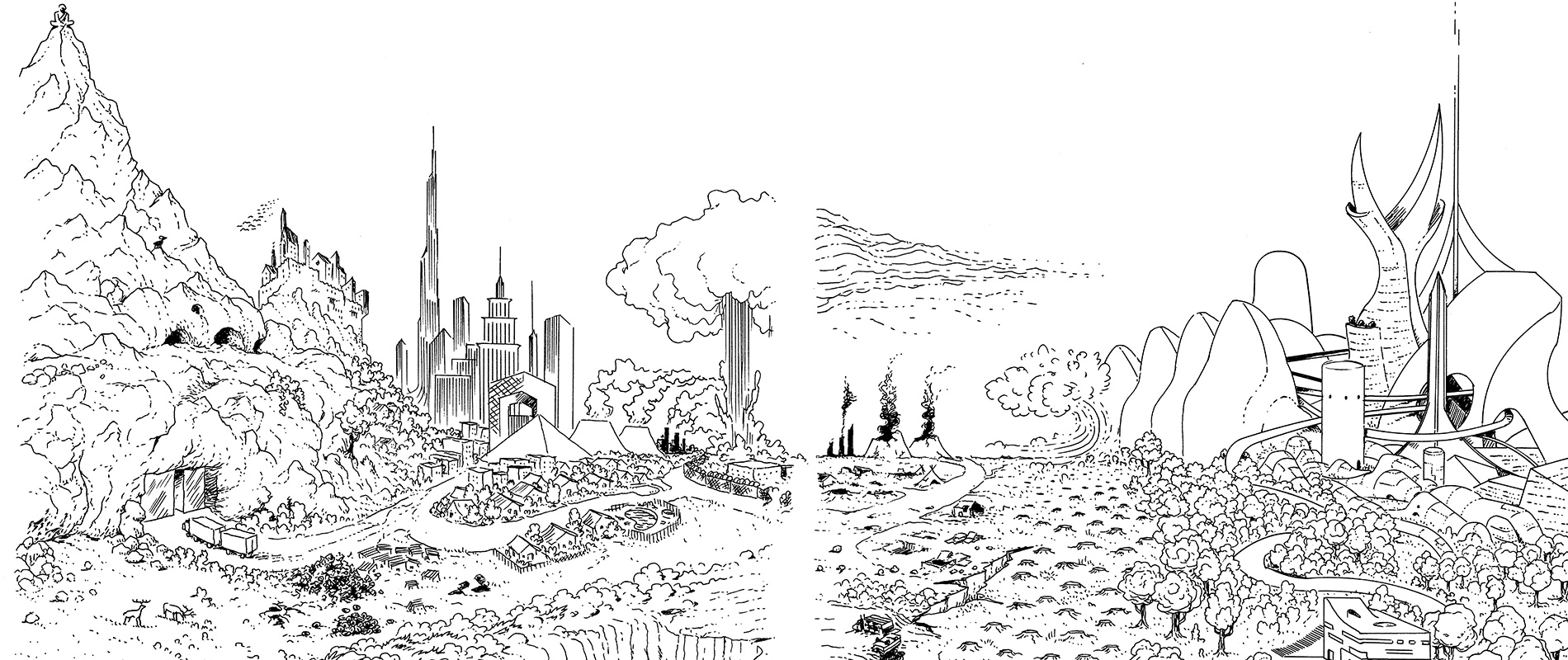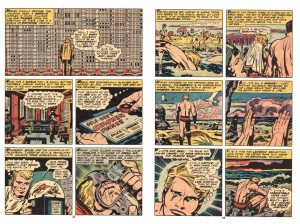It was my pleasure and an honor to have been interviewed by James Romberger for the Hooded Utilitarian. I already wrote that his work was very important to me in my formative years. Getting the chance to publish his new work and getting to know him has been a blast! Here’s a little excerpt where we splice Jack Kirby with J.G. Ballard:
James: I just read another interview with you that Kent Worcester did, where you cited a specific Jack Kirby image from his 2001 comic, a panel of a man walking up to a building that is just a huge wall of windows—it freaked me out because that is one of my favorites of Kirby’s and it is part of a passage that I had actually thought of mentioning to you! The Earth Jack depicts is so polluted and crowded, a world where pure air can only be breathed out of bottles that one must purchase as we do water, an existence so dehumanized that the protagonist feels he must join the space program, to escape in order to realize any sort of life for himself.
Jack Kirby, from “Norton of New York, 2040 A.D.”, 2001 #5, Marvel Comics, 1977
Your work gives me a similar feeling, as if you are dealing with expressing what it is like to live in a world that has gone beyond the point of no return, but with no escape possible, as if all we can do is construct semblances of sanity for ourselves, that work within the insane structures that we must fit into.
Tom: I love that Kirby image! I believe that was from 2001 #5? I agree with what you’re saying here. One of my favorite J.G. Ballard stories is “Billenium” about an overcrowded world where everyone basically lives on top of everyone else. The protagonists in that story find a hidden room and all that new space is an almost unimaginable luxury. They proceed to share the new space with some friends and family until it fills up and becomes indistinguishable from the rest of the world. We need to find these spaces (whether real or imagined) and inhabit them; to create germs of possible and impossible new worlds… hopefully better ones. There’s a danger in that. Things could get worse… but sometimes not doing anything at all, is worst of all. One thing I hesitate doing in my stories is to destroy the world. If “Billenium” was an Italo Calvino story, that room could be a germ of a new city; an invisible city growing in the midst of the old one… and eventually it would grow to replace it. I think we need a better imagination, one that goes beyond wishing for the apocalypse.
Of course the interview was primarily about Beta Testing the Apocalypse. Here’s a little exchange on the index of the book (yes, I love talking about the index!):
James: I’ve never seen an index that alphabetically listed every sound effect in a comic before. And Ballard’s entry leads to a highway sign in a panel for “Ballard Golf Heaven”, and I liked how the table of contents is figured on a greater timeline, but isn’t much help in locating the stories. Such details play with the new climate in comics where we should try to accommodate future scholarship, by ensuring that page numbers are included, etc.—-you certainly left a lot of room for examining this thing through different “lenses”….we’ve come a long way!
Tom: Ha! Well, it’s something I’ve always wanted to do with comics. Indices, notes, and glossaries are some of my favorite things in books and I didn’t want my book to be left out! This all comes out of lots of conversations I’ve had with cartoonists and writers over the last few years. In the end I wanted the index to be another story in the book. One that comments and explicates the other stories. Some entries are in there for fun. Like the sound effects, or cars. Others alert the reader to concepts or phrases that have been quoted, mutated or just plain stolen. One thing that is often left out of comics criticism are the images. They are often examined in terms of plot or composition, but rarely do writers get into the complex visual references that often show up in comics. One of my favorites pieces of writing on comics is a Ken Parille piece on Clowes’ David Boring that excavated the connections to Hitchcock’sVertigo among many other things. I hope in some future edition, the book can be published with an index. Other cartoonists have played with this kind of material. Kevin Huizenga comes to mind with fake indices & glossaries. In fact I was just working with Kevin (& Dan Zettwoch) on the index to their next book, Amazing Facts & Beyond. It’s amazing and goes way beyond my index! In fact they called it the beyondex! Maybe we can start a trend! Index wars!
Check out the rest of the interview here. Check out James’ Post York, and the new edition of 7 Miles a Second. Beta Testing the Apocalypse is available here.

